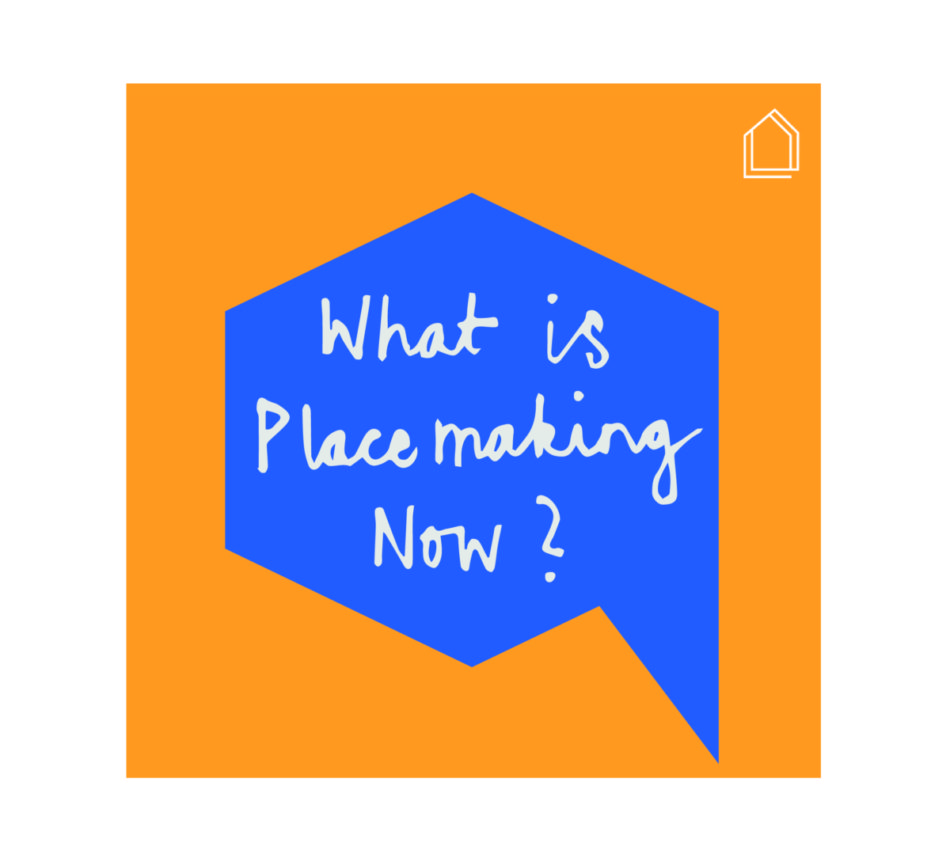Written by:
When we work with a new group, be they professionals, community members or students, we find that the crucial first step is to define the language and terminology we will be using during the project. Not only is this important to ensure we are all working towards the same goals and ideas, but creating a shared lexicon can be a fantastic first activity to build a shared rapport and understanding.
With this in mind, we kicked off our new series with this month’s Chat, ‘What is Placemaking Now?’, bringing together a diverse room of built environment and community-based practitioners, artists and students to explore the constantly evolving language of placemaking, and how this affects how we consider, design and build places.
Key Themes
We started this Chat by sharing our personal definitions and experiences of placemaking, which were each influenced by our own experiences of cities, towns, and practising in a rich tapestry of different spaces. We discussed how definitions of common buzzwords within the world of placemaking can get pulled and shifted as different interpretations are drawn from them, and contemplated how we might use the language of co-design to make sure it doesn’t reflect a tokenstic engagement process.
We hoped that this Chat may help us pin down some clearer definitions for placemaking, co-design and engagement, but instead what emerged from our conversation were a set of values that the Chat participants felt are important for an engaged placemaking process. Often a set of definitions can become stagnant and restrictive, whilst a set of values identifies core facets of placemaking that are essential for its success, whilst giving flexibility to the notion of what placemaking is which gives room for us all to bring our own flavour to the mix.
Placemaking with Intent and Accountability
Within our own work, and from talking with our Chat participants whose experiences echoed our own, buzzwords like ‘co-design’ and ‘engaged design’ are now showing up more regularly in design and engagement projects. Whilst this reflects the changing landscape around participative design, upon closer inspection it is often revealed that the developer, local authority or funding organisation are unfamiliar with the realities of an engaged design journey. To some, there is also a concern that these phrases are being used to placate communities without a true commitment to the work, time and relationships that need to be built into an engaged design process.
Regardless of vocabulary or meaning, we agreed that the intent behind engaging a community of stakeholders is the most important value. If the intent is there for an engaged design process, one that puts true effort into providing diverse opportunities for local stakeholders to be involved in a myriad of ways, then the likelihood is that the engagement journey will create a vibrant and valued place.
When collaborative buzzwords are being used more and more commonly to describe design processes, we asked ourselves, “Who makes sure that the design process described or promised as co-design, actually does what it says on the tin?”. This question opens the door to another host of considerations, but also brings a valid core concern – how do we protect co-design from becoming a gentrified term? We concurred that the diversity of co-design processes is one of its strengths, and a design journey with just a small level of engagement is better than one with none at all.
To ensure an upstanding co-design process, we should strive to hold ourselves, our clients and our community of practitioners accountable to ensure engaged placemaking processes do what they say on the tin, and in spaces where these phrases are being thrown around, advocate for engaged placemaking processes with meaning.
Placemaking through Inviting and Listening
When considering the language of placemaking, we naturally questioned the very meaning of the word. Is placemaking the formal act of designing and building places, the hard infrastructure that governs our urban spaces, or is it the soft bits in between, the drinks at the pub or walking your child to school, that makes places what they are? We agreed that it is both, and because we all take part in these ‘softer’ placemaking activities that are routed in place, we are all placemakers (even if we don’t know it).
So, how do we get these ‘unknown’ placemakers involved when more formal, engaged design processes happen to their local places? We often use the term ‘empowerment’ when referring to this process, but one of our Chat participants raised a thought-provoking challenge to this, asking “Who are you to empower me? I have my own power”. Instead, they advocated for an invitation, and an inviting process, to give people the space, resources and time to take part in design and engagement conversations.
Placemaking is about inviting people into creating shared experiences, activities and spaces, and often extending that invitation over and over in a variety of different ways. But what is most important is that if people take that invitation, that their contributions are listened to and valued.
Placemaking with Power and Compromise
Placemaking is also about compromise. Places, and the communities within them, are made up of such a diverse network of individuals, each with their own hopes, aspirations and concerns for the present and future of their local place. How can we, within or outside of design engagement processes, hope to capture and create places that reflect each of these qualities? The simple answer is we can’t, not as individual desires – but when we come together to form communities, we can talk, draw and work together to find common values within this myriad of opinions, and through compromise we can reach a shared consensus.
However, within this it’s also important to consider barriers to placemaking, which includes barriers to placemakers being involved in engaged design processes in order to reach consensus. When considering urban areas, many of which have already been through development journeys resulting in a level of historic distrust in ideas such as co-design or collaborative design, compromise can be a very difficult ask. It’s important to acknowledge this history, alongside existing power dynamics which affect placemaking and placemakers alike.
Wrapping up
Our first Chat of this series provided some interesting provocations and thoughts to consider when approaching placemaking as an engaged process, and we rounded up the Chat space by highlighting each of these ‘values of placemaking’ that had stood out to us. Placemaking is bigger than a singular designer producing something in isolation, and instead needs to be more widely considered as the balancing act of bringing lots of people, interests, needs, concerns and ideas into play to produce places that are better than the sum of their parts.
In this brief summary I’ve captured just a small portion of the diverse and stimulating conversation from our October Chat, but if you want to explore other voices from this Chat space check out our Chat Voices capture on Instagram. Join us at our next Glass-House Chat, you can find the details and book your free place on our Series 3 page here.


